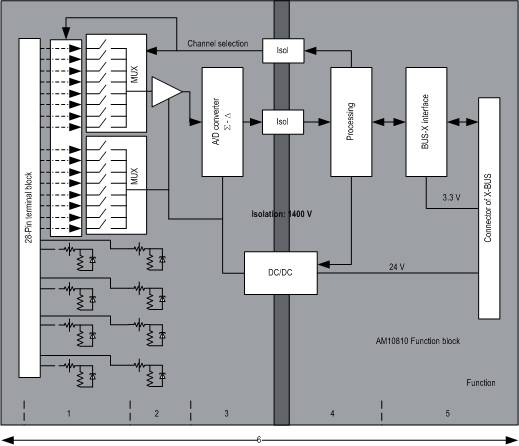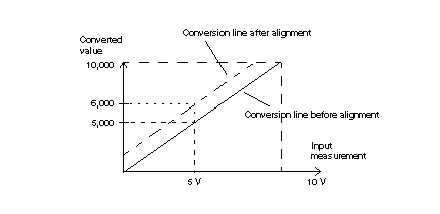|
Functional Description
|
|
|
Original instructions
|

|
No.
|
Process
|
Function
|
|---|---|---|
|
1
|
Adapting the Inputs and Multiplexing
|
|
|
2
|
Amplifying Input Signals
|
|
|
3
|
Converting
|
|
|
4
|
Transforming incoming values into workable measurements for the user.
|
|
|
5
|
Communicating with the Application
|
|
|
6
|
Module monitoring and sending error notification back to application.
|
Conversion string test
Testing for range overflow on channels
Watchdog test
|
|
Module
|
Normal Cycle
|
Fast Cycle
|
|---|---|---|
|
BMX AMI 0810
|
9 ms
|
1 ms + (1 ms x N)
where N: number of channels in use.
|


|
Designation
|
Description
|
|---|---|
|
Nominal range
|
measurement range corresponding to the chosen range
|
|
Upper Tolerance Area
|
varies between the values included between the maximum value for the range (for instance: +10 V for the +/-10 V range) and the upper threshold
|
|
Lower Tolerance Area
|
varies between the values included between the minimum value for the range (for instance: -10 V for the +/-10 V range) and the lower threshold
|
|
Overflow Area
|
area located beyond the upper threshold
|
|
Underflow Area
|
area located below the lower threshold
|
|
Range
|
BMX AMI 0810 Range
|
|||||||||
|---|---|---|---|---|---|---|---|---|---|---|
|
Underflow Area
|
Lower Tolerance Area
|
Nominal Range
|
Upper Tolerance Area
|
Overflow Area
|
||||||
|
Unipolar
|
||||||||||
|
0...10 V
|
-1,500
|
-1,001
|
-1,000
|
-1
|
0
|
10,000
|
10,001
|
11,000
|
11,001
|
11,400
|
|
0...5 V /
0...20 mA
|
-5,000
|
-1,001
|
-1,000
|
-1
|
0
|
10,000
|
10,001
|
11,000
|
11,001
|
15,000
|
|
1...5 V /
4...20 mA
|
-4,000
|
-801
|
-800
|
-1
|
0
|
10,000
|
10,001
|
10,800
|
10,801
|
14,000
|
|
Bipolar
|
||||||||||
|
+/- 10 V
|
-11,500
|
-11,001
|
-11,000
|
-10,001
|
-10,000
|
10,000
|
10,001
|
11,000
|
11,001
|
11,400
|
|
+/- 5 V,
+/- 20 mA
|
-15,000
|
-11,001
|
-11,000
|
-10,001
|
-10,000
|
10,000
|
10,001
|
11,000
|
11,001
|
15,000
|
|
User
|
||||||||||
|
+/- 10 V
|
-32,768
|
|
User-defined
|
User-defined
|
32,767
|
|||||
|
0...10 V
|
-32,768
|
|
User-defined
|
User-defined
|
32,767
|
|||||
|
Type of Range
|
Display
|
|---|---|
|
Unipolar range
0...10 V, 0...5 V, 1...5 V, 0...20mA, 4...20mA
|
from 0 to 10,000 (0 % at +100.00 %)
|
|
Bipolar range
+/- 10 V, +/- 5 mV +/- 20 mA
|
from -10,000 to 10,000 (-100.00 % at +100.00 %)
|

|
Desired Efficiency
|
Required Value
|
Corresponding α
|
Filter Response Time at 63%
|
Cut-off Frequency (in Hz)
|
|---|---|---|---|---|
|
No filtering
|
0
|
0
|
0
|
0
|
|
Low filtering
|
1
2
|
0.750
0.875
|
4 x T
8 x T
|
0.040 / T
0.020 / T
|
|
Medium filtering
|
3
4
|
0.937
0.969
|
16 x T
32 x T
|
0.010 / T
0.005 / T
|
|
High filtering
|
5
6
|
0.984
0.992
|
64 x T
128 x T
|
0.0025 / T
0.0012 / T
|
